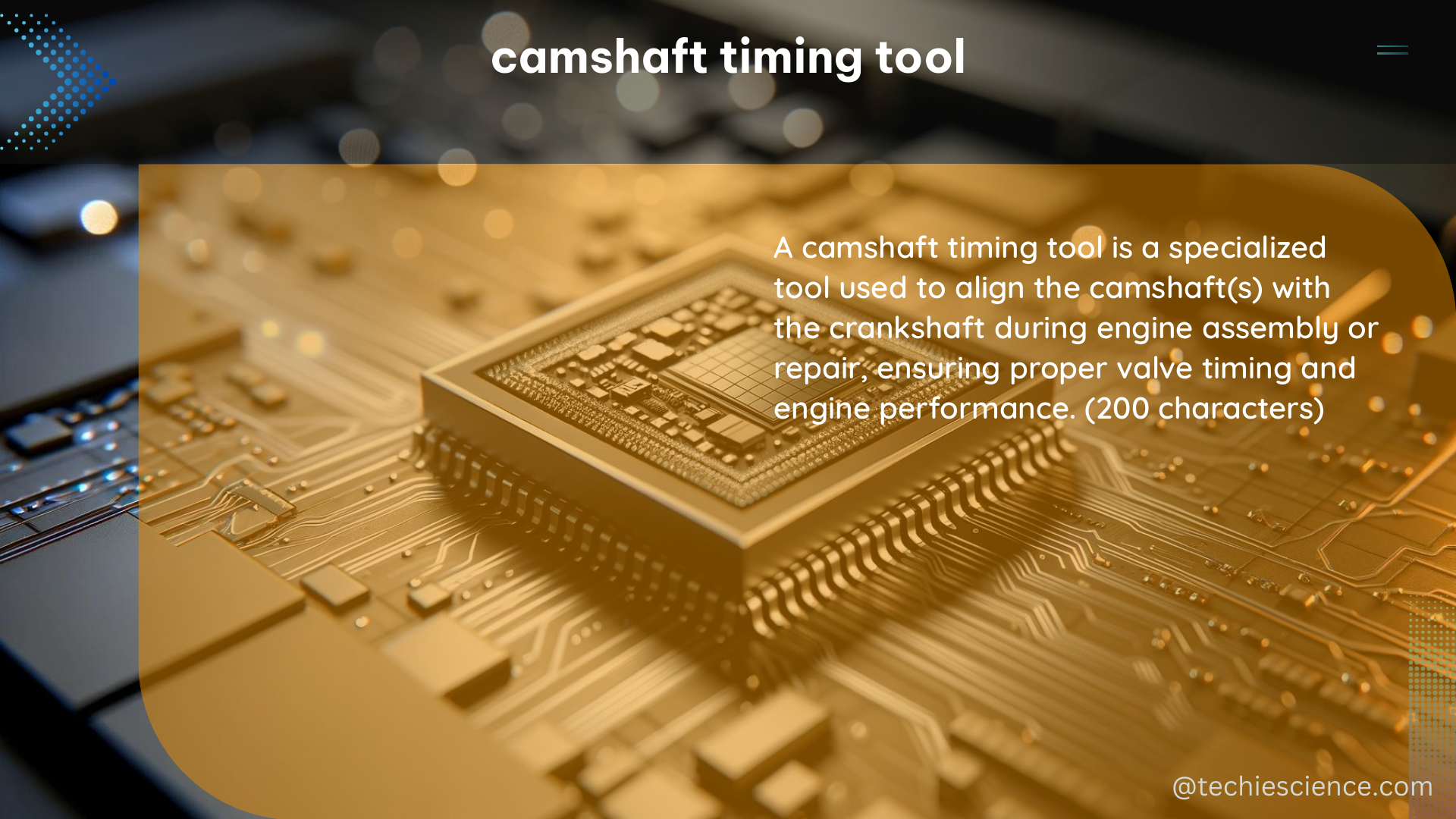The camshaft timing tool is a critical component in the engine rebuilding process, particularly when replacing the timing chain. It ensures that the camshafts and crankshaft are correctly aligned, which is essential for the engine to run smoothly and efficiently. This comprehensive guide will delve into the technical details, usage, and importance of the camshaft timing tool, providing a valuable resource for DIY enthusiasts and professional mechanics alike.
Understanding the Camshaft Timing Tool
The camshaft timing tool is a specialized piece of equipment designed to fit specific engine types. It typically consists of a base plate that attaches to the engine block and a movable tool that aligns with the camshafts. The tool may have adjustable arms or indicators to ensure accurate alignment.
Technical Specifications
- Base Plate: The base plate is the foundation of the camshaft timing tool, designed to securely attach to the engine block. It is typically made of durable materials, such as steel or aluminum, to withstand the rigors of the engine rebuilding process.
- Movable Tool: The movable tool is the heart of the camshaft timing tool, responsible for aligning with the camshafts. It may feature adjustable arms or indicators to ensure precise positioning.
- Adjustment Mechanisms: Camshaft timing tools often include adjustment mechanisms, such as knobs or screws, that allow the user to fine-tune the alignment of the movable tool with the camshafts.
- Compatibility: Camshaft timing tools are designed to fit specific engine types, so it’s essential to select the correct tool for your engine model to ensure a proper fit and accurate alignment.
Importance of Accurate Timing Alignment
Proper timing alignment is crucial for the engine to run smoothly and efficiently. If the camshafts and crankshaft are not correctly aligned, it can lead to a range of issues, including:
- Reduced Engine Performance: Misaligned timing can result in a loss of power, reduced fuel efficiency, and decreased engine responsiveness.
- Increased Wear and Tear: Incorrect timing can cause excessive wear on engine components, such as the timing chain, camshafts, and valvetrain, leading to premature failure and the need for costly repairs.
- Emission Issues: Improper timing can also contribute to increased emissions, which can be problematic for vehicles in areas with strict environmental regulations.
Preparing the Engine for Camshaft Timing Tool Installation

Before using the camshaft timing tool, the engine block must be properly prepared. This typically involves the following steps:
- Removing the Cylinder Heads: The cylinder heads must be removed to provide access to the camshafts and crankshaft.
- Removing the Timing Cover: The timing cover must be removed to expose the timing chain or belt, as well as the timing marks on the sprockets or gears.
- Aligning the Camshafts and Crankshaft: The camshafts and crankshaft must be aligned using the timing marks on the sprockets or gears. This ensures that the engine is in the correct position for the camshaft timing tool installation.
Using the Camshaft Timing Tool
Once the engine is properly prepared, the camshaft timing tool can be installed and used to ensure accurate timing alignment. The process typically involves the following steps:
- Attaching the Base Plate: The base plate of the camshaft timing tool is securely attached to the engine block, ensuring a stable and secure foundation.
- Aligning the Movable Tool: The movable tool is then aligned with the camshafts, using the adjustment mechanisms to fine-tune the positioning.
- Verifying Alignment: The user should carefully verify the alignment of the camshafts and crankshaft using the timing marks and the camshaft timing tool’s indicators.
- Installing the Timing Chain or Belt: With the camshaft timing tool in place and the alignment verified, the timing chain or belt can be installed.
- Reassembling the Engine: After the timing chain or belt is installed, the engine can be reassembled, including the replacement of the cylinder heads and timing cover.
Troubleshooting and Best Practices
When using the camshaft timing tool, it’s important to be aware of potential issues and follow best practices to ensure a successful engine rebuild. Some common troubleshooting tips and best practices include:
- Verifying Crankshaft Position: Ensure that the crankshaft is in the correct position by checking that the straws in the cylinders are even.
- Consulting the Manufacturer’s Instructions: Always refer to the manufacturer’s instructions for the specific camshaft timing tool and engine model to ensure proper usage and alignment.
- Maintaining Tool Condition: Keep the camshaft timing tool in good condition by cleaning and storing it properly to prevent damage or wear.
- Seeking Professional Assistance: If you encounter any issues or are unsure about the proper use of the camshaft timing tool, it’s best to seek the assistance of a professional mechanic.
Conclusion
The camshaft timing tool is a crucial component in the engine rebuilding process, ensuring accurate alignment of the camshafts and crankshaft. By understanding the technical specifications, importance of accurate timing, and proper usage of the tool, DIY enthusiasts and professional mechanics can ensure a successful engine rebuild and maintain the smooth and efficient operation of their vehicles.
References:
– Timing Possibly Off? – Camshaft Tool Isn’t Sitting Right, North American Motoring, 2018-06-17, https://www.northamericanmotoring.com/forums/stock-problems-issues/328573-timing-possibly-off-camshaft-tool-isn-t-sitting-right.html
– Cam Timing tool – M838T, McLaren Life, 2021-09-21, https://www.mclarenlife.com/threads/cam-timing-tool-m838t.105645/
– Analysis of quantitative metrics for assessing resilience of human …, Nature, 2023-02-20, https://www.nature.com/articles/s41598-023-29735-1

The lambdageeks.com Core SME Team is a group of experienced subject matter experts from diverse scientific and technical fields including Physics, Chemistry, Technology,Electronics & Electrical Engineering, Automotive, Mechanical Engineering. Our team collaborates to create high-quality, well-researched articles on a wide range of science and technology topics for the lambdageeks.com website.
All Our Senior SME are having more than 7 Years of experience in the respective fields . They are either Working Industry Professionals or assocaited With different Universities. Refer Our Authors Page to get to know About our Core SMEs.